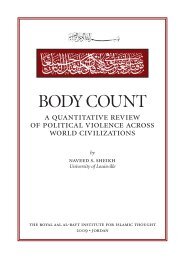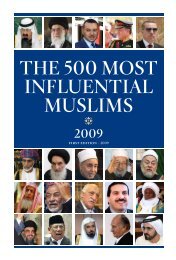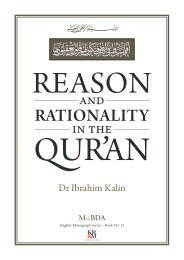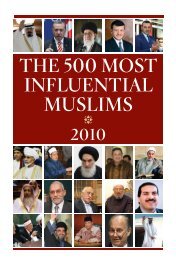the 500 most influential muslims - The Royal Islamic Strategic ...
the 500 most influential muslims - The Royal Islamic Strategic ...
the 500 most influential muslims - The Royal Islamic Strategic ...
You also want an ePaper? Increase the reach of your titles
YUMPU automatically turns print PDFs into web optimized ePapers that Google loves.
Grand Ayatollah Khamenei is <strong>the</strong> Supreme Leader of<br />
<strong>the</strong> <strong>Islamic</strong> Republic of Iran. He was born in Mashhad<br />
in <strong>the</strong> far north east of Iran, and studied in <strong>the</strong> leading<br />
Iranian religious seminary in Qom, before becoming<br />
involved in <strong>the</strong> struggle with <strong>the</strong> Pahlavi Regime in<br />
<strong>the</strong> sixties and seventies.<br />
Supreme Leader, Velayat-e Faqih<br />
Khameini's current influence stems from his powerful<br />
position as a religious leader, which gives him a unique<br />
role in political affairs. His job is to enact <strong>the</strong> Velayat-e Faqih—<strong>the</strong> guardianship of <strong>the</strong><br />
jurist. In real terms this means a system where scholars of fiqh (<strong>Islamic</strong> jurisprudence)<br />
have a controlling say in <strong>the</strong> political affairs of <strong>the</strong> state. <strong>The</strong> rule of <strong>the</strong> jurist was a<br />
concept created by Ayatollah Ruhollah Khomeini, based on ideas that have run through<br />
Iranian political history since <strong>the</strong> time of Shah Ismail—who was <strong>the</strong> first to make Shi‘a<br />
Islam <strong>the</strong> national religion of Iran. It was conceived in a battle against oppression as a<br />
way of safeguarding <strong>the</strong> Iranian nation from tyranny, giving <strong>the</strong> final say in all matters to<br />
a group of religious scholars, <strong>the</strong> Council of Guardians. This Council is headed by a chief<br />
arbitrator—<strong>the</strong> Supreme Leader.<br />
Leader of Shi‘a Revolution<br />
Khamenei gains much of his influence in Iran from his role as a leader of <strong>the</strong> <strong>Islamic</strong><br />
Revolution. <strong>The</strong> <strong>Islamic</strong> Republic of Iran was forged out of <strong>the</strong> 1979 Iranian Revolution.<br />
Combating what many saw as <strong>the</strong> tyrannical rule of <strong>the</strong> Shah, Khamenei joined <strong>the</strong><br />
Society of Combatant Clergy that staged demonstrations mobilizing many of <strong>the</strong> protests<br />
leading to <strong>the</strong> Shah's overthrow. After <strong>the</strong> revolution in 1979 he was one of <strong>the</strong> founding<br />
members of <strong>the</strong> <strong>Islamic</strong> Republic Party, and a member of <strong>the</strong> assembly of experts that<br />
was responsible for drafting Iran's new constitution.<br />
24<br />
2<br />
his eMinence grand ayatollah<br />
hajj sayyid ali khaMenei<br />
Supreme Leader of <strong>the</strong> <strong>Islamic</strong> Republic of Iran<br />
Country: Iran<br />
Date of Birth: 17 July 1939<br />
Source of Influence: Political,<br />
Administrative<br />
Influence: Supreme Leader of 72<br />
million Iranians<br />
School of Thought: Traditional<br />
Twelver Shi‘a, Revolutionary<br />
Shi'ism















